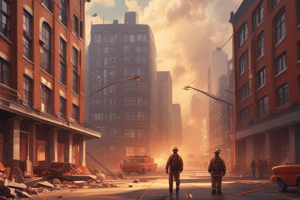Podcast
Questions and Answers
Why is it necessary for ground-level forces to withdraw to a specific distance from a wall in a bowstring truss described in the content?
Why is it necessary for ground-level forces to withdraw to a specific distance from a wall in a bowstring truss described in the content?
- To ensure the safety of other responders.
- To maintain a tactical position against potential adversaries.
- To avoid less obvious threats from nearby objects.
- Bowstring truss construction has a collapse radius that is larger due to explosive force (correct)
What alternative strategies are suggested if responders cannot maintain a safe distance from a threatening wall?
What alternative strategies are suggested if responders cannot maintain a safe distance from a threatening wall?
- Call for additional reinforcements to secure the area.
- Set up defensive positions within the immediate vicinity.
- Engage in a frontal assault on the wall.
- Establish flanking positions or utilize an elevating platform. (correct)
What potential danger should firefighters be cautious of when moving out of one collapse zone to another?
What potential danger should firefighters be cautious of when moving out of one collapse zone to another?
- The collapse zone of intersecting sidewalls. (correct)
- Exposed electrical wiring from nearby lines.
- The chance of encountering hostile individuals.
- Falling debris from adjacent buildings only.
What is a risk associated with using an elevating platform during a fire-related incident?
What is a risk associated with using an elevating platform during a fire-related incident?
According to the safety measures discussed, how tall could the fireball be during a roof collapse?
According to the safety measures discussed, how tall could the fireball be during a roof collapse?
In which types of buildings are V-shaped collapses most likely to occur?
In which types of buildings are V-shaped collapses most likely to occur?
What is the likely consequence for victims situated directly below a V-shaped collapse?
What is the likely consequence for victims situated directly below a V-shaped collapse?
What characteristic is typically associated with the void spaces created by V-shaped collapses?
What characteristic is typically associated with the void spaces created by V-shaped collapses?
Which of the following scenarios can lead to a V-shaped collapse occurring?
Which of the following scenarios can lead to a V-shaped collapse occurring?
In the context of V-shaped collapses, where are victims likely to be thrown during the collapse?
In the context of V-shaped collapses, where are victims likely to be thrown during the collapse?
What characteristic defines an A-frame collapse?
What characteristic defines an A-frame collapse?
In an A-frame collapse caused by an explosion, where are the void areas most likely to be found?
In an A-frame collapse caused by an explosion, where are the void areas most likely to be found?
How does the pressure from an explosion affect the structure during an A-frame collapse?
How does the pressure from an explosion affect the structure during an A-frame collapse?
Which conclusion can be drawn about survival rates in A-frame collapses compared to V-shaped collapses?
Which conclusion can be drawn about survival rates in A-frame collapses compared to V-shaped collapses?
What is the primary reason pancake collapses are not considered inherently unstable?
What is the primary reason pancake collapses are not considered inherently unstable?
In assessing a pancake collapse, which aspect is most critical to determine safety?
In assessing a pancake collapse, which aspect is most critical to determine safety?
What role do strong objects play in survival situations during pancake collapses?
What role do strong objects play in survival situations during pancake collapses?
What is the primary cause of a supported lean-to collapse?
What is the primary cause of a supported lean-to collapse?
What happens to the floor or roof when one bearing wall fails?
What happens to the floor or roof when one bearing wall fails?
Which building classes are specifically mentioned as having made rescues from pancake collapses?
Which building classes are specifically mentioned as having made rescues from pancake collapses?
What aspect of pancake collapses must responders carefully examine for a complete assessment?
What aspect of pancake collapses must responders carefully examine for a complete assessment?
Where are people most likely to find large voids after a lean-to collapse?
Where are people most likely to find large voids after a lean-to collapse?
What specific group has the lowest chance of survival during a lean-to collapse?
What specific group has the lowest chance of survival during a lean-to collapse?
In a lean-to collapse scenario, what is likely to happen to objects on the floor above?
In a lean-to collapse scenario, what is likely to happen to objects on the floor above?
What occurs during an unsupported lean-to collapse?
What occurs during an unsupported lean-to collapse?
Which scenario represents a supported lean-to void?
Which scenario represents a supported lean-to void?
What is a critical safety measure while operating under overhanging debris?
What is a critical safety measure while operating under overhanging debris?
What should be done before pulling down overhanging debris?
What should be done before pulling down overhanging debris?
What is the condition of the low end of a supported lean-to that poses severe danger?
What is the condition of the low end of a supported lean-to that poses severe danger?
What is a defining characteristic of individual voids in a collapse?
What is a defining characteristic of individual voids in a collapse?
In what scenario is locating victims considered simpler during a collapse?
In what scenario is locating victims considered simpler during a collapse?
What types of objects may contribute to the formation of individual voids?
What types of objects may contribute to the formation of individual voids?
What challenge arises when attempting to locate individual voids?
What challenge arises when attempting to locate individual voids?
What can sometimes be a possibility regarding movement within individual voids?
What can sometimes be a possibility regarding movement within individual voids?
V shaped collapses usually occur in class __ or __ buildings having wooden floor joist, when these joist are either overloaded, have a center support removed or are burned away under load
V shaped collapses usually occur in class __ or __ buildings having wooden floor joist, when these joist are either overloaded, have a center support removed or are burned away under load
__ frame collapses are common in explosions
__ frame collapses are common in explosions
Flashcards
Collapse Distance
Collapse Distance
Maintain a safety distance of at least 2.5 times the height of a potentially collapsing structure.
V-shaped Collapse
V-shaped Collapse
Collapse where the center collapses, leaving the exterior walls standing, forming two voids.
A-frame Collapse
A-frame Collapse
A collapse where a strong center support causes outer portions to fall.
Supported Lean-to Collapse
Supported Lean-to Collapse
Signup and view all the flashcards
Unsupported Lean-to Collapse
Unsupported Lean-to Collapse
Signup and view all the flashcards
Pancake Collapse
Pancake Collapse
Signup and view all the flashcards
Secondary Threats
Secondary Threats
Signup and view all the flashcards
Elevated Positions
Elevated Positions
Signup and view all the flashcards
Class 3 Buildings
Class 3 Buildings
Signup and view all the flashcards
Class 5 Buildings
Class 5 Buildings
Signup and view all the flashcards
Individual Voids
Individual Voids
Signup and view all the flashcards
Narrow Streets Safety
Narrow Streets Safety
Signup and view all the flashcards
Collapse Survival Zones
Collapse Survival Zones
Signup and view all the flashcards
Load Transfer
Load Transfer
Signup and view all the flashcards
Stability Assessment
Stability Assessment
Signup and view all the flashcards
Survivor Search
Survivor Search
Signup and view all the flashcards
Debris Removal
Debris Removal
Signup and view all the flashcards
Wooden Joists
Wooden Joists
Signup and view all the flashcards
Fireball Hazard
Fireball Hazard
Signup and view all the flashcards
Study Notes
Safety Protocols Around Potential Collapses
- Maintain a distance of at least 2.5 times the wall height from structures that could suddenly collapse.
- In narrow streets or tight spaces, consider flanking positions or utilize elevating platforms for safety.
- Be aware of secondary threats like trees, poles, and power lines in the area during a collapse.
- Elevated positions pose risks, including potential fireball eruptions from falling roofs; avoid being directly above the collapse area.
Types of Collapses
- Five recognized collapse types:
- V-shape
- A-frame
- Supported lean-to
- Unsupported lean-to (cantilever)
- Pancake
V-shaped Collapses
- Common in Class 3 or 5 buildings with wooden joists under load or compromised structure.
- The center portion collapses while exterior walls remain standing, creating two voids on the sides.
- Survivors are often found near the edges, while those beneath the collapse have the least chance of survival.
A-frame Collapses
- Occur when a strong central support maintains the structure, causing outer ends to fall.
- Frequently result from explosions; voids are near the central supporting structures.
- Survivors are more likely to be found near the center support rather than the edges.
Supported Lean-to Collapses
- Triggered by failure at one end of a support structure, creating a sloping design.
- Objects above will accumulate at the lowered end, presenting potential survival opportunities for those nearby.
- Seek voids along remaining walls for enhanced chances of finding survivors.
Unsupported Lean-to Collapses
- Feature dangling joists held by a standing wall, leading to risks of further collapse.
- Extreme caution needed when searching beneath unsupported areas; may require removal of debris post-survivor search to ensure safety.
Pancake Collapses
- Floors drop in layers, resembling stacked pancakes, and often rest securely on the lower levels.
- Investigate the lowest level to assess load transfer and stability, avoiding further collapse into lower areas.
- Rescues are feasible in Class 3 and 5 buildings if strong nearby objects are intact.
Individual Voids
- Created by strong objects that remain standing during a collapse, leading to random spaces.
- More difficult to locate due to their irregular occurrence based on furniture and layout.
- Victims in pancake collapses are easier to find since layers typically maintain their structure and position.
Studying That Suits You
Use AI to generate personalized quizzes and flashcards to suit your learning preferences.



